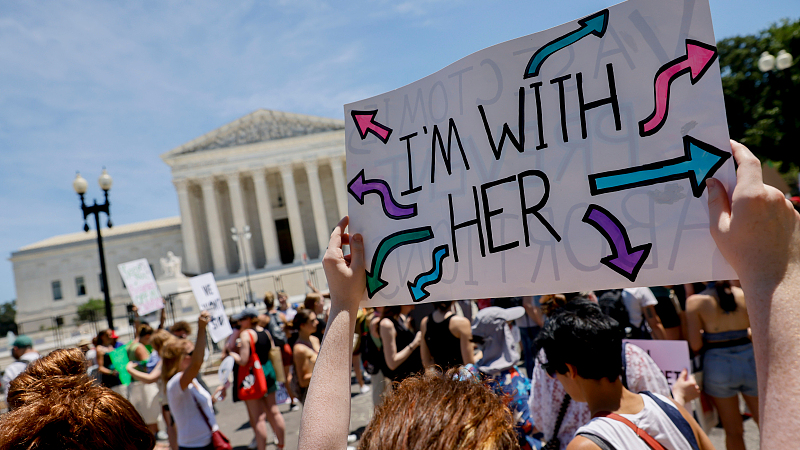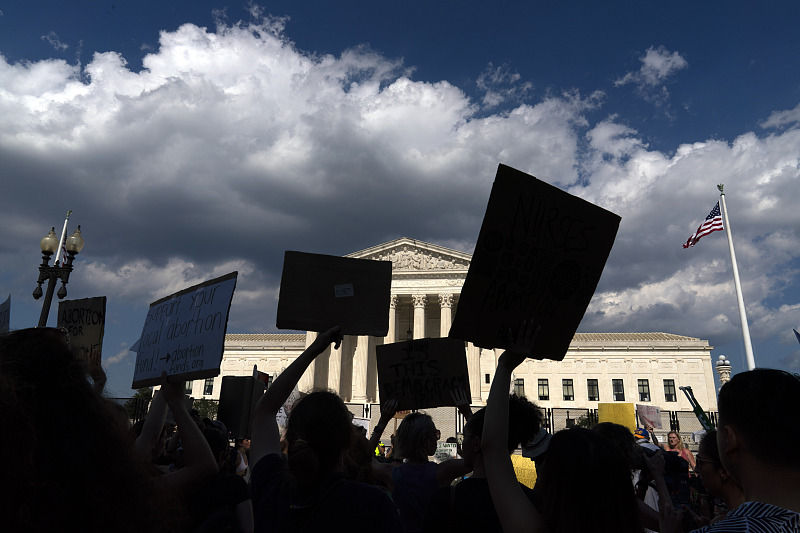
Abortion rights demonstrators during an "Abortion is Freedom" rally outside the U.S. Supreme Court in Washington, D.C., U.S., July 4, 2022. /CFP
Abortion rights demonstrators during an "Abortion is Freedom" rally outside the U.S. Supreme Court in Washington, D.C., U.S., July 4, 2022. /CFP
Editor's note: Yi Xin is a Beijing-based observer. The article reflects the author's opinions and not necessarily the views of CGTN.
The case of a 10-year-old abuse victim in Ohio who was denied abortion care in her own state because she was three days past six weeks pregnant and forced to cross state borders to travel to Indiana for the procedure has accentuated the shocking impact of the U.S. Supreme Court's landmark ruling overturning Roe v. Wade, which had guaranteed a constitutional right to an abortion in the U.S. for nearly 50 years.
The court's out-of-control rightward march has once again spotlighted the uphill battle that women in the U.S. are still fighting for equality, life, liberty and the pursuit of happiness, self-evident truth and human's unalienable rights enshrined in the founding document of this country 246 years ago.
Even today, women in the U.S. still face systemic and institutionalized discrimination, and gender bias continues to create huge barriers for many of them.
The U.S. has reaped great benefits from the increasing role that women have played in the economy, who according to the latest U.S. Bureau of Labor Statistics (BLS) report make up 56.2 percent of the country's workforce. However, women still cannot get the same recognition as their male counterparts for the work they do.
The gap in earnings between men and women still exists in the U.S. And progress has slowed lately. The BLS report shows that women still make just 78 cents for every dollar earned by men, an increase of only 17 cents since the Equal Pay Act of 1963 was enacted.
The figures are even dimmer for women of color due to the persistence of intersecting gender, race and ethnic biases. Black women are paid only 64 cents and Latinas only 54 cents for every dollar that white men earn.
Over the course of the first 10 months of the pandemic in the U.S., women - particularly women of color - have lost more jobs than men since women are disproportionately employed in jobs in the service sector and informal economy, which have been hit the hardest by the crisis. Overall, women have lost a net of 5.4 million jobs in this 10-month period, nearly one million more job losses than men. Women who were already treading water before the pandemic are bearing the brunt of the economic blow.
On top of inequality, there is the problem of discrimination, both covert and overt. Although the Pregnancy Discrimination Act of 1978 had outlawed pregnancy discrimination, workers who are pregnant or breastfeeding are often fired or pushed out of the workplace. This practice is rooted in the post-World War II social stereotype that women should be mothers, not workers, in order to free up the jobs that their men returning from conflict would now need. Such a stereotype, which should have long been a thing of the past, is instead reinforced by workplace policies modeled on traditional male norms and persists to this day.
Despite the fact that the U.S. is one of the world's wealthiest countries, it is an outlier among developed countries in failing to guarantee access to paid maternity leave, a policy adopted by the International Labor Organization in November 1919. As a matter of fact, it is the only OECD country that does not guarantee any form of paid maternity leave at the national level, making it among the most limited and restricted countries on maternity leave policy.

Abortion rights activists protest outside the Supreme Court in Washington, D.C., U.S., June 25, 2022. /CFP
Abortion rights activists protest outside the Supreme Court in Washington, D.C., U.S., June 25, 2022. /CFP
Its 1993 Family and Medical Leave Act, which entitles new parents up to 12 weeks of unpaid leave, only covers 60 percent of the U.S. workforce.
A recent BLS report indicates that only 26 percent of women in government jobs and 23 percent in private or civilian jobs have access to paid maternity leave.
Women make up the majority of the beneficiaries of Medicaid, the country's health coverage program for poor and low-income people. However, it only covers about 40 percent of all births in the U.S. and expires 60 days after childbirth, leaving many women without health insurance at one of the most vulnerable times in their lives.
As a result, women in the U.S. are forced to choose between balancing the physical needs of their recovering bodies and the financial needs of returning to work, and this prompted one in four women to return to work just two weeks after delivery.
Unequal economic opportunities, discrimination and the lack of proper legal protection during women's vulnerable times combined have exacerbated the struggles women in the U.S. face for their survival.
The Women's Legal Defense and Education Fund finds that women in the U.S. are 35 percent more likely than men to be poor.
85 percent of domestic violence victims in the U.S. are women. Every nine seconds in the U.S. a woman is assaulted or beaten. The U.S. Department of Justice reports that approximately one in four homeless women is homeless because of violence committed against her.
As per the Gates Foundation, the maternal mortality rate is higher in the U.S. than any other developed country, with the mortality rate among black mothers three times higher than white women. Each year, about 700 women die during or after labor or in the first month after delivering, and most of these deaths are preventable.
The fact that this is happening in 2022 in the country which prides itself as the "beacon of democracy" and human rights champion is embarrassing and thought-provoking.
One day before the overturning of Roe v. Wade, the U.S. Supreme Court had made another controversial ruling — the overturning of a 1913 New York handgun-licensing law, New York State Rifle & Pistol Association v. Bruen, which required New Yorkers who want to carry a handgun in public to show a special need to defend themselves.
By striking down this law, the court declared for the first time, amid the height of rampant gun violence, that the U.S. Constitution protects an individual's right to carry a handgun in public for self-defense.
And the next day, the same court denied women's right to choose.
Women's rights are an inalienable, integral and indivisible part of universal human rights. The deficiencies that the U.S. has, and its appalling backward trend in protecting women's rights are outrageous.
Back at home, U.S. politicians have said on many occasions that they know their country is not perfect, and one of the country's great strengths is that they don't sweep problems under the rug to pretend that they don't exist. However, it is not enough to just openly discuss or debate deficiencies. The bottom line is: They must be addressed.
(If you want to contribute and have specific expertise, please contact us at opinions@cgtn.com. Follow @thouse_opinions on Twitter to discover the latest commentaries in the CGTN Opinion Section.)

